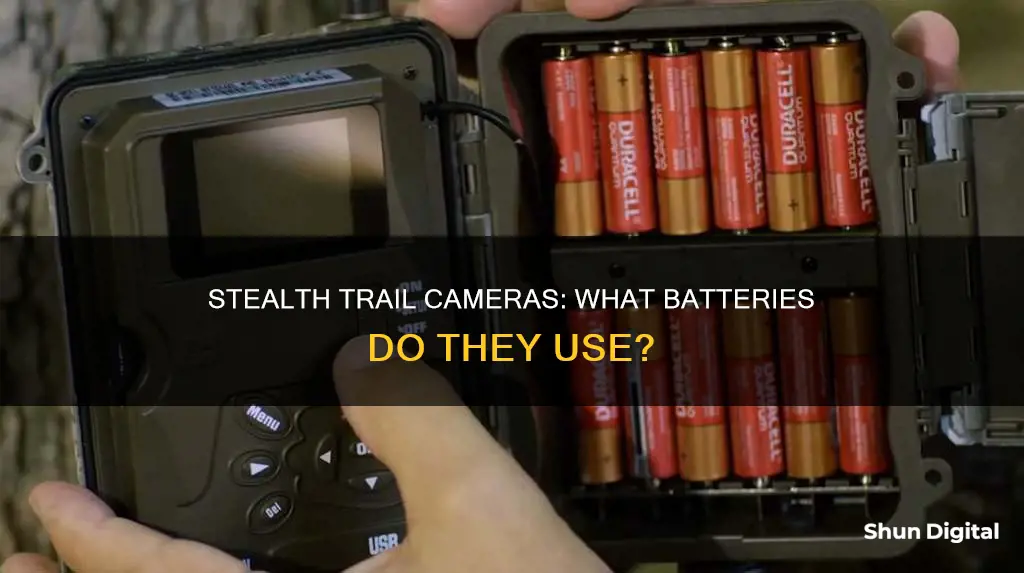
There are a few types of batteries that can be used in stealth trail cameras. The most common types are alkaline, NiMH rechargeable, and lithium batteries. The type of battery you choose will depend on your specific needs and preferences. Alkaline batteries are the least expensive option and work well in warm to moderate temperatures, but they lose charge quickly in cool and cold weather. Lithium batteries are more expensive but are not affected by temperature changes and have a longer battery life. NiMH rechargeable batteries are not typically recommended for trail cameras as they don't work well and most manufacturers advise against them. Ultimately, the best type of battery for a stealth trail camera will depend on factors such as temperature, the number of pictures taken, and the desired battery life.
| Characteristics | Values |
|---|---|
| Recommended battery type | Lithium |
| Other battery types | Alkaline, Nickel-metal hydride (NiMH) rechargeable, Rechargeable lithium |
| Factors affecting battery life | Temperature, number of pictures taken, day vs. night ratio, video recording, rechargeable batteries, night shooting, trigger delay |
| Lithium battery advantages | Reliable, longer battery life, unaffected by temperature changes, 20% longer runtime than best rechargeable cells, twice the runtime of best alkaline batteries, weigh less |
| Lithium battery disadvantages | Expensive, unpredictable battery life |
| Alkaline battery advantages | Cheap, widely available |
| Alkaline battery disadvantages | Inconsistent power, don't work well in cold temperatures, unreliable, prone to leaking acid |
| NiMH rechargeable battery advantages | Longer battery life in winter months, cheaper in the long run |
| NiMH rechargeable battery disadvantages | Adversely affected by hot weather, incompatible with some trail camera models, low voltage |
What You'll Learn
- Lithium batteries are the most reliable and longest-lasting option
- Alkaline batteries are cheap and widely available but provide inconsistent power
- NiMH rechargeable batteries are not suited for trail cameras
- Cold temperatures reduce battery power
- Solar panels and battery boxes are alternative power sources

Lithium batteries are the most reliable and longest-lasting option
When it comes to trail camera batteries, there are a few options available, each with its own advantages and drawbacks. However, lithium batteries stand out as the most reliable and longest-lasting choice for several reasons.
Firstly, lithium batteries offer exceptional performance and longevity. They produce 1.6 volts per cell, resulting in brighter pictures and an increased flash range. This higher voltage also contributes to their longer runtime, providing up to 20% more capacity than rechargeable cells and doubling the runtime of alkaline batteries. This extended capacity translates to fewer battery changes and reduced maintenance for your trail camera.
Another advantage of lithium batteries is their remarkable consistency across varying temperatures. Unlike other battery types, lithium batteries are unaffected by extreme heat or cold. This makes them ideal for use in remote areas with challenging climate conditions, ensuring your trail camera remains operational regardless of the weather.
Additionally, lithium batteries offer a significant weight advantage. Single-use lithium cells weigh substantially less than alkaline or NIMH cells, making them a backpacker's dream when venturing into remote locations to manage cameras. This weight difference can make a noticeable difference when every ounce counts.
While lithium batteries were once praised for their consistent power delivery, recent price increases and a rise in the number of defective cells have slightly dampened their appeal. Nevertheless, they remain a reliable option, especially when compared to the limitations of other battery types.
In summary, lithium batteries offer unparalleled reliability, extended runtime, temperature stability, and lightweight convenience, making them the superior choice for stealth trail cameras. Their consistent performance and durability ensure your trail camera captures every moment without interruption, providing you with a wealth of images and data.
Simplisafe Camera Costs: When Do You Get Charged?
You may want to see also

Alkaline batteries are cheap and widely available but provide inconsistent power
Alkaline batteries are the most widely available and least expensive option for powering stealth trail cameras. However, they have several drawbacks that can impact their performance in these devices.
Firstly, alkaline batteries provide inconsistent power. They are shipped with a power level of about 1.5 volts but begin to decrease in power as soon as they are inserted. This decrease in voltage continues over time, affecting the number of photos taken and their quality, especially at night. As the battery life diminishes, the brightness and illumination of night photos decrease until they eventually become pitch black, or the camera shuts off due to low voltage.
Another issue with alkaline batteries is their performance in cold temperatures. They lose up to half of their capacity in sub-freezing weather, which can result in periods of inactivity for trail cameras. Additionally, alkaline batteries are prone to leaking acid, which can damage devices. They are also not environmentally friendly, as they are single-use and often end up in landfills.
Despite these drawbacks, alkaline batteries do have one advantage. They can operate in higher temperatures without any performance loss, making them a cost-effective alternative to rechargeable batteries in hot climates.
Overall, while alkaline batteries are cheap and readily available, their inconsistent power output, temperature sensitivity, and environmental impact make them a less reliable option for stealth trail cameras.
Monthly Fees for Cellular Cameras: What's the Deal?
You may want to see also

NiMH rechargeable batteries are not suited for trail cameras
NiMH rechargeable batteries are not the best option for trail cameras, and there are several reasons why. Firstly, NiMH batteries have a lower voltage output than other battery types. While most trail cameras are designed for 1.5V batteries, NiMH batteries only provide 1.2V, which can cause issues with some camera models. This lower voltage can also result in weaker flash performance, leading to darker night photos.
Secondly, NiMH batteries are adversely affected by hot weather. Their performance drops significantly at temperatures around 38°C and above 90°F, which can result in shorter battery life and missed photos. This makes them unsuitable for use in warm environments or during the summer months.
Thirdly, the quality of NiMH rechargeable batteries can vary greatly. Many widely available rechargeable batteries have small milliamp-hour (mAh) capacities, which can result in poor performance and short battery life. It's important to check the mAh capacity before purchasing to ensure the batteries will meet your needs.
Finally, the use of a cheap charger can also affect the performance of NiMH batteries. Inexpensive chargers may overcharge the batteries, causing them to overheat and lose future capacity or even fail immediately.
For these reasons, lithium batteries are often recommended as the best choice for trail cameras, as they offer higher voltage, longer battery life, and better performance in extreme temperatures. While they are more expensive, their increased capacity and reliability can make them a more cost-effective option in the long run.
Charging the Vantop Moment 4: A Step-by-Step Guide
You may want to see also

Cold temperatures reduce battery power
Stealth trail cameras are often powered by AA batteries, with lithium batteries being the most recommended type. Lithium batteries are super reliable and offer the longest battery life. However, cold temperatures can significantly reduce battery power, affecting the performance of trail cameras.
Battery capacity is closely linked to temperature, and as the temperature decreases, the battery capacity decreases as well. At extremely low temperatures, such as 22°F (-30°C), battery capacity can drop to half of its rated capacity at room temperature. This reduction in capacity can cause issues with trail cameras, as they may not capture photographs or function properly until the temperature rises again.
The impact of cold on batteries is due to the slowing down of chemical reactions within the battery. In lithium-ion batteries, the particles involved in the chemical reaction that creates a charge move slower in colder temperatures, resulting in reduced power and a smaller charge. This can lead to difficulties in providing sufficient energy to power a device, such as a trail camera.
Additionally, when batteries are left idle in cold environments for extended periods, they can sustain irreversible damage. Lithium-ion batteries, in particular, undergo physical changes that impair their capacity. The internal components contract, hindering the transfer of electrons between electrodes. This disruption can lead to the formation of lithium dendrites that puncture the diaphragm, resulting in battery failure.
To mitigate the effects of cold temperatures on trail camera batteries, it is advisable to use batteries specifically designed for cold weather applications. These batteries employ various strategies, such as using different materials or adding insulation, to maintain power output in colder conditions. Regular batteries may not be able to withstand extreme cold and could fail prematurely.
Charging the Blackmagic Camera: A Step-by-Step Guide
You may want to see also

Solar panels and battery boxes are alternative power sources
Solar panels for trail cameras typically come with a built-in rechargeable lithium battery and a cable for connecting to the camera. Some solar panels are designed to be compatible with specific trail camera models, while others are more universal. When choosing a solar panel, it is important to consider the weather conditions it will be exposed to and ensure that it is sufficiently durable and weather-resistant.
One example of a solar panel for trail cameras is the GardePro SP350 Universal Solar Panel, which is compatible with a range of trail camera brands. Another option is the Stealth Cam SOL-PAK 5X, which includes a 12V solar power panel, a rechargeable battery, and a 10-foot insulated cable. This solar panel is compatible with all wireless and cellular trail cameras.
Battery boxes, such as the HME 12V Battery pack, offer another alternative power source for trail cameras. This option provides a sealed 12V lead-acid battery that is ideal for extreme temperatures and comes with a pre-attached solar panel for continual charging.
It is worth noting that the type of battery used in trail cameras can also make a significant difference in performance. Lithium batteries, for example, are known for their reliability and long battery life, but they can be expensive. Other options include alkaline batteries, which are widely available and inexpensive but may not perform well in cold temperatures and have a shorter battery life.
Best Camera Batteries: 3000mAh Options and More
You may want to see also
Frequently asked questions
Stealth Trail Cameras use AA batteries. There are three basic types of AA batteries readily available for these cameras: Alkaline (standard), NiMH Rechargeable, and Lithium batteries.
Lithium batteries are reliable and offer the longest battery life. They are also ideal for use in cool and cold weather locations as they are generally not affected by freezing temperatures.
Yes, Lithium batteries are more expensive than Alkaline batteries, and they go from full charge to no charge without warning. So, if your camera shows a 99% charge on Monday, it might be completely dead by Friday.
Although NiMH Rechargeable batteries are available, most manufacturers advise against using them in trail cameras. They don't work well and can cause problems.
It is recommended to use Energizer or Duracell Alkaline batteries in your Stealth Trail Camera. Off-brand alkaline batteries tend to have substantially less capacity and are very unreliable.







